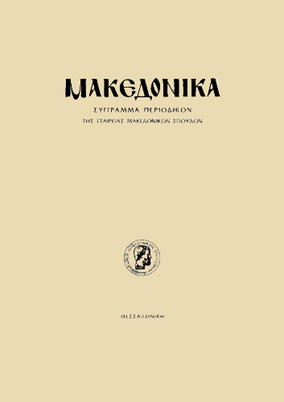Οι τοιχογραφίες του Αγίου Βλασίου της Μονής Μεγίστης Λαύρας στο Άγιον Όρος
Part of : Μακεδονικά ; Vol.31, 1998, pages 93-119
Issue:
Pages:
93-119
Parallel Title:
The Frescoes in Ayos Vlassios near the Monastery of the Great Lavra on Mount Athos
Section Title:
Articles
Abstract:
This study publishes the frescoes in the Church of Ayos Vlassios near the Great Lavra on Mount Athos. The church is a small aisleless barrel-vaulted structure (6.90x4.80 m) with a semicircular apse and lavishly decorated with frescoes. Around 1529, minor interventions on the architecture of the shell partially destroyed the frescoes on the north and south walls.The surviving frescoes predate the renovation of 1529 and are in a comparatively good state of preservation. They compose an integrated, chronologically unified iconographical programme that is of particular interest with regard to artistic trends in fifteenth-century painting.The main feature of the decoration is the simplicity of the iconographical programme, which is limited to fourteen scenes from the Twelve Feasts, and the absence of some fundamental scenes from the Christological cycle, such as the Deposition from the Cross and the Threnos. The tendency to limit the iconographical programme to basic scenes from the Twelve Feasts, with no em phasis on the Passion cycle, is observed, as we have seen, in aisleless churches in Macedonia from the last quarter of the fourteenth century onwards, and was one of the trends of the iconography of this period that prevailed in the fifteenth century.From an iconographical point of view, the scenes with their simple iconographical format and the individual iconographical types in the Ayos Vlassios paintings derive from the iconographical tradition of Palaeologan art at the turn of the fifteenth century in monuments in Macedonia, or else they show some connection with works of the Cretan school in the fifteenth century.From an artistic point of view, the Ayos Vlassios frescoes continued on Mount Athos in the fifteenth century modes of painting from the last quarter of the fourteenth and the first quarter of the fifteenth century that are seen chiefly in churches in Macedonia. The close iconographical connections between the Ayos Vlassios frescoes and works of the «Macedonian» and the Cretan school in the fifteenth century, together with their affiliation, despite a difference in quality, with the paintings at Kalenic in terms of the typology of the forms, the technique of rendering the faces, drapery, and landscape, and the palette, suggest that they may be dated to the first half of the fifteenth century.
Notes:
856:https://ejournals.epublishing.ekt.gr/index.php/makedonika/article/view/5676, DOI: https://doi.org/10.12681/makedonika.115
Electronic Resources:




